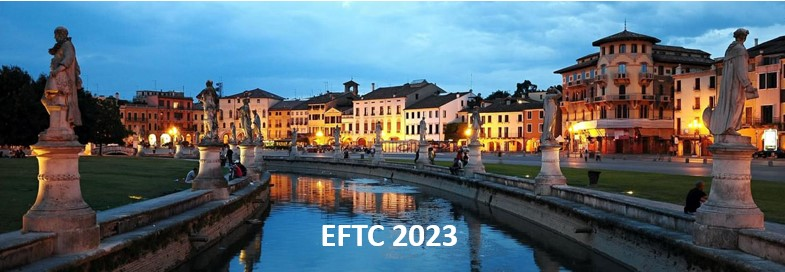Speaker
Description
Advanced transport models for energetic particles
Ph. Lauber 1, M. Falessi 2, A. Biancalani 3, A. Bottino 1, S. Briguglio 2, N. Carlevaro 2, V. Fusco 2,T. Hayward-Schneider 1, F. Holderied 1, A. Könies 4, Y. Li 2,6,Y.-Y. Li2 ,5,6, G. Meng 1, A. V. Milovanov 2, G. Montani 2, V.-A. Popa 1, S. Possanner 1, G. Vlad 2, X. Wang 1, M. Weiland 1, A. Zocco 4, F. Zonca 2
1 Max-Planck-Institut für Plasmaphysik, Boltzmannstraße 2, D-85748 Garching, Germany
2 ENEA, Fusion and Nuclear Safety Department, C. R. Frascati, I-00044 Frascati (Rome), Italy
3 Léonard de Vinci Pôle Universitaire, Research Center, F-92916 Paris La Défense, France
4 Max-Planck-Institut für Plasmaphysik, D-17491 Greifswald, Germany
5 National Supercomputing Center of Tianjin, Tianjin, China
6 CREATE Consortium, Via Claudio 21, Napoli, Italy
In addition to increasingly realistic non-linear global simulations [1, 2, 3], a hierarchy of theory-based re- duced models is needed to complement the predictions concerning the performance of future burning plas- mas. Large parameter scans, sensitivity studies and multi-scale physics connecting energetic particle trans- port with neoclassical (transport) time scales require tools that go beyond what is presently feasible with first-principles numerical codes. In the view of this challenge we report in this work on the construction, validation and application of reduced energetic particle (EP) transport models pursued within the framework of the EUROFusion enabling research project ATEP (Advanced Transport models for EPs).
The general theoretical framework introduces the concept of long-lived toroidally symmetric structures in the particle phase space (phase space zonal structures, PSZS) that are separated from fast fluctuating contri- butions [4, 5, 6, 7]. Comprehensive transport equations have been derived that are designed to capture the evolution of PSZSs on collisional transport time scales while keeping the important non-linear interactions in a consistent multi-scale description. The model captures physics beyond simpler models (critical gradi- ent, kick model, quasi-linear) that, however, can be recovered in the appropriate limits. A generalisation of the theory to stellarator geometry has been started [8]. The DAEPS code [9] and the EP-stability workflow (EP-WF) [10] based on the code chain HELENA-LIGKA-HAGIS [11, 12, 13] deliver the necessary input for the PSZS transport equations, i.e. the orbit-and zonally-averaged response for a selected set of markers to a prescribed set of Alfvénic perturbations. In addition, neoclassical transport coefficients [14] for the same set of markers, and general EP distribution functions as calculated by various heating workflows[15] are pro- vided via standardised IMAS interfaces. The transport equation is then consistently evolved, or EP diffusion coefficients are evaluated for the use in standard transport codes. In addition, a 1d reduced model based on the beam-plasma bump-on-tail paradigm that is designed to go beyond the quasi-linear approximation and thus forecast possible EP transport transitions such as avalanching has been successfully compared to the LIGKA/HAGIS model. The formulation of the models allows one to carry out detailed analyses of transport scaling laws (diffusive/non-diffusive) for both Alfvénic gap and energetic particle modes using Lagrangian coherent structures (LCS) [16, 17]. The verification of the reduced models is carried out via comparison to numerical codes in the appropriate limits (HYMAGYC, (X)HMGC, STRUPHY, ORB5, HAGIS/LIGKA [18, 19, 20]). To that end, the implementation of PSZS diagnostics in the various codes [21, 22] provides a natural connection point for benchmarking with the reduced models. Several time-dependent scenarios from present-day and future experiments (in particular AUG [23], JT-60SA, TCV, DTT, JET,ITER) have been collected and are being analysed.
In summary, the PSZS transport theory and the LIGKA-HAGIS workflow ATEP provide a new and promis- ing approach to address the challenge of describing EP transport in fusion plasmas. With their ability to capture multi-scale physics, account for non-linear interactions, and forecast transport transitions, these re-
duced models have significant potential to enhance our understanding of EP transport.
This work has been carried out within the framework of the EUROfusion Consortium, funded by the European Union via the Euratom Research and Training Programme (Grant Agreement No 101052200 – EUROfusion). Views and opinions expressed are however those of the author(s) only and do not necessarily reflect those of the European Union or the European Commission. Neither the European Union nor the European Commission can be held responsible for them.
References:
[1] A. Mishchenko et al, Proc. 29th IAEA FEC, London UK (2023)
[2] T. Hayward-Schneider et al, Proc. 29th IAEA FEC, London UK (2023)
[3] A. Biancalani et al, Proc. 29th IAEA FEC, London UK (2023)
[4] F. Zonca et al, New Journal of Physics 17 013052 (2015)
[5] M V Falessi et al, Phys. Plasmas 26 022305 (2019)
[6] M. V. Falessi et al https://arxiv.org/pdf/2306.08642.pdf (2023)
[7] M V Falessi et al, Proc. 29th IAEA FEC, London UK (2023)
[8] A. Zocco et al, Journal of Plasma Physics 89, 905890307 (2023)
[9] Y. Li et al, PoP 27 062505, (2020).
[10] V.-A. Popa et al, submitted (2023)
[11] G.T.A. Huysmans et al, Proc. CP90 Conf. on Comp. Phys. Proc., 371, (1991)
[12] Ph. Lauber et al, J. Comp. Phys., 226/1 (2007)
[13] S.D. Pinches, Comp. Phys. Comm., 111 (1998)
[14] G Meng et al, Proc. 29th IAEA FEC, London UK (2023)
[15] M. Schneider et al, TH/6-1 Proc. 27th IAEA FEC, 2018
[16] N. Carlevaro et al, Proc. 48th EPS Conference on Plasma Physics, (2022)
[17] A. V. Milovanov et al, Phys. Rev. E 103 052218 (2021)
[18] G. Vlad et al, Nucl. Fusion 61 116026 (2021); Proc. 29th IAEA FEC, London UK (2023)
[19] X. Wang et al, PoP. 29 032512 (2022)
[20] F. Holderied et al, JCP 433 110143 (2021); 464 111329 (2022)
[21] S. Briguglio et al, PoP 21 112301 (2014)
[22] A. Bottino et al, J. Phys.: Conf. Ser. 2397 012019 (2022)
[23] Ph. Lauber et al, Proc. 27th IAEA FEC (2018)
